coolant MITSUBISHI COLT 2008 (in English) User Guide
[x] Cancel search | Manufacturer: MITSUBISHI, Model Year: 2008, Model line: COLT, Model: MITSUBISHI COLT 2008Pages: 450, PDF Size: 14.57 MB
Page 299 of 450
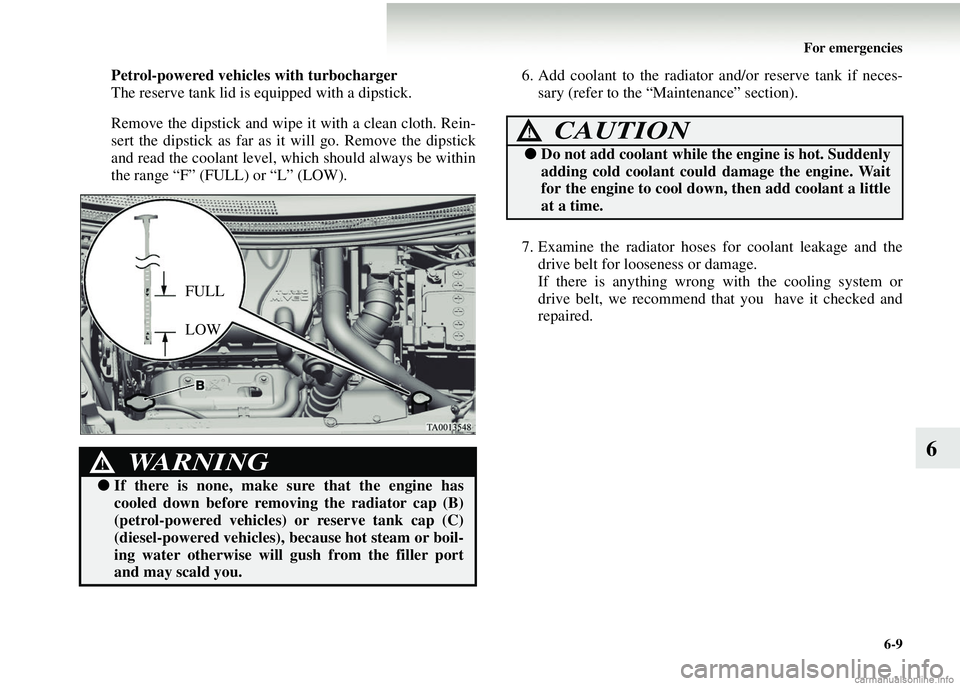
For emergencies6-9
6
Petrol-powered vehicles with turbocharger
The reserve tank lid is equipped with a dipstick.
Remove the dipstick and wipe it with a clean cloth. Rein-
sert the dipstick as far as it will go. Remove the dipstick
and read the coolant level, which should always be within
the range “F” (FULL) or “L” (LOW). 6. Add coolant to the radiator
and/or reserve tank if neces-
sary (refer to the “Maintenance” section).
7. Examine the radiator hoses for coolant leakage and the drive belt for looseness or damage.
If there is anything wrong with the cooling system or
drive belt, we recommend that you have it checked and
repaired.
WARNING!
● If there is none, make sure that the engine has
cooled down before removi ng the radiator cap (B)
(petrol-powered vehicles) or reserve tank cap (C)
(diesel-powered vehicles), because hot steam or boil-
ing water otherwise will gush from the filler port
and may scald you.
FULL
LOW
CAUTION!
● Do not add coolant while the engine is hot. Suddenly
adding cold coolant coul d damage the engine. Wait
for the engine to cool down, then add coolant a little
at a time.
Page 343 of 450
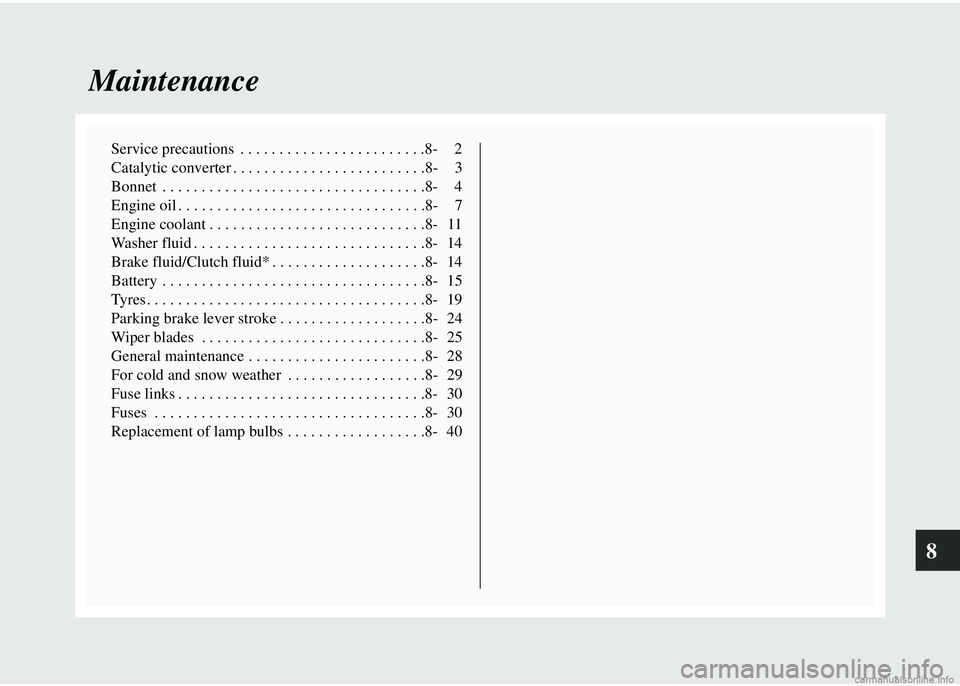
8
Maintenance
Service precautions . . . . . . . . . . . . . . . . . . . . . . . .8- 2
Catalytic converter . . . . . . . . . . . . . . . . . . . . . . . . .8- 3
Bonnet . . . . . . . . . . . . . . . . . . . . . . . . . . . . . . . . . .8- 4
Engine oil . . . . . . . . . . . . . . . . . . . . . . . . . . . . . . . .8- 7
Engine coolant . . . . . . . . . . . . . . . . . . . . . . . . . . . .8- 11
Washer fluid . . . . . . . . . . . . . . . . . . . . . . . . . . . . . .8- 14
Brake fluid/Clutch fluid* . . . . . . . . . . . . . . . . . . . .8- 14
Battery . . . . . . . . . . . . . . . . . . . . . . . . . . . . . . . . . .8- 15
Tyres . . . . . . . . . . . . . . . . . . . . . . . . . . . . . . . . . . . .8- 19
Parking brake lever stroke . . . . . . . . . . . . . . . . . . .8- 24
Wiper blades . . . . . . . . . . . . . . . . . . . . . . . . . . . . .8- 25
General maintenance . . . . . . . . . . . . . . . . . . . . . . .8- 28
For cold and snow weather . . . . . . . . . . . . . . . . . .8- 29
Fuse links . . . . . . . . . . . . . . . . . . . . . . . . . . . . . . . .8- 30
Fuses . . . . . . . . . . . . . . . . . . . . . . . . . . . . . . . . . . .8- 30
Replacement of lamp bulbs . . . . . . . . . . . . . . . . . .8- 40
Page 353 of 450
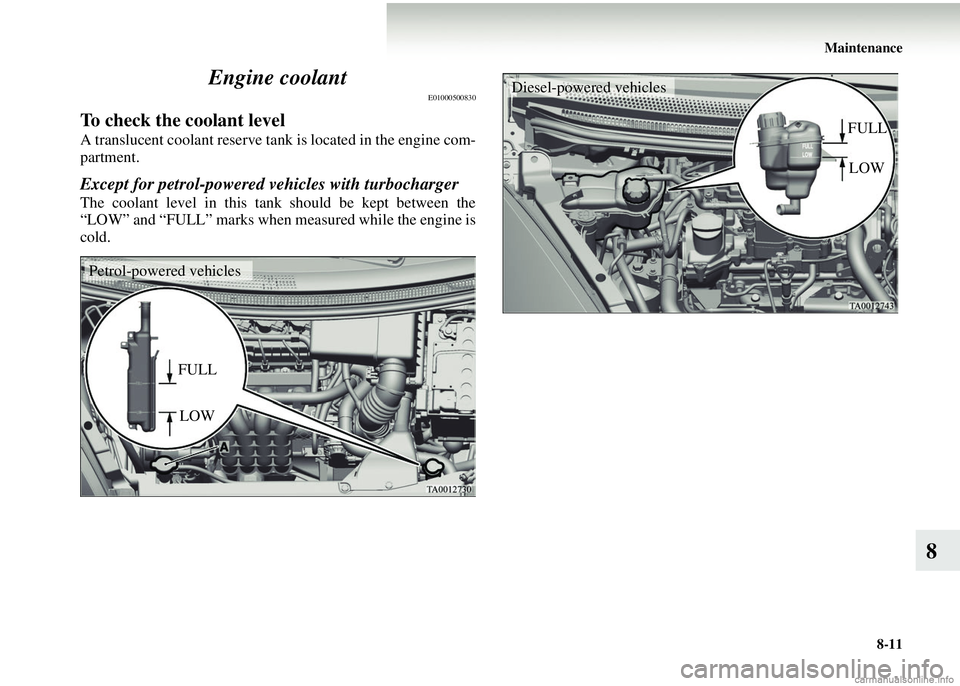
Maintenance8-11
8
Engine coolant
E01000500830
To check the coolant level
A translucent coolant reserve tank
is located in the engine com-
partment.
Except for petrol-powered vehicles with turbocharger
The coolant level in this tank should be kept between the
“LOW” and “FULL” marks when measured while the engine is
cold.
FULL
LOW
Petrol-powered vehicles
Diesel-powered vehicles
FULLLOW
Page 354 of 450
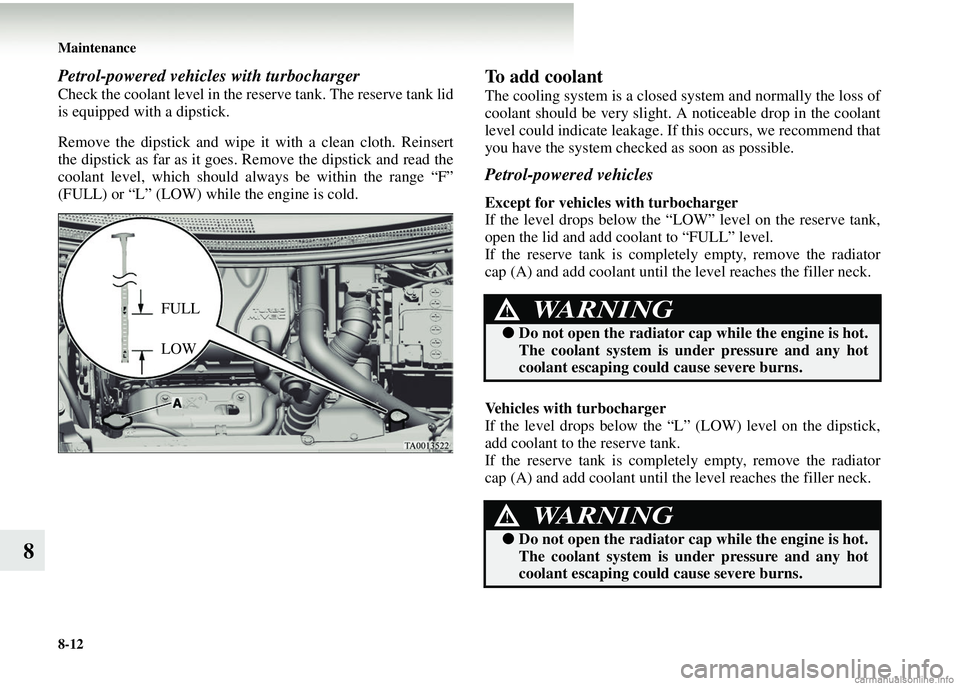
8-12 Maintenance
8
Petrol-powered vehicles with turbocharger
Check the coolant level in the reserve tank. The reserve tank lid
is equipped with a dipstick.
Remove the dipstick and wipe it with a clean cloth. Reinsert
the dipstick as far as it goes. Remove the dipstick and read the
coolant level, which should always be within the range “F”
(FULL) or “L” (LOW) while the engine is cold.
To add coolant
The cooling system is a closed system and normally the loss of
coolant should be very slight. A noticeable drop in the coolant
level could indicate leakage. If this occurs, we recommend that
you have the system checked as soon as possible.
Petrol-powered vehicles
Except for vehicles with turbocharger
If the level drops below the “LOW” level on the reserve tank,
open the lid and add coolant to “FULL” level.
If the reserve tank is completely empty, remove the radiator
cap (A) and add coolant until the level reaches the filler neck.
Vehicles with turbocharger
If the level drops below the “L” (LOW) level on the dipstick,
add coolant to the reserve tank.
If the reserve tank is completely empty, remove the radiator
cap (A) and add coolant until the level reaches the filler neck.
FULL
LOWWARNING!
● Do not open the radiator ca p while the engine is hot.
The coolant system is u nder pressure and any hot
coolant escaping coul d cause severe burns.
WARNING!
●Do not open the radiator ca p while the engine is hot.
The coolant system is u nder pressure and any hot
coolant escaping coul d cause severe burns.
Page 355 of 450
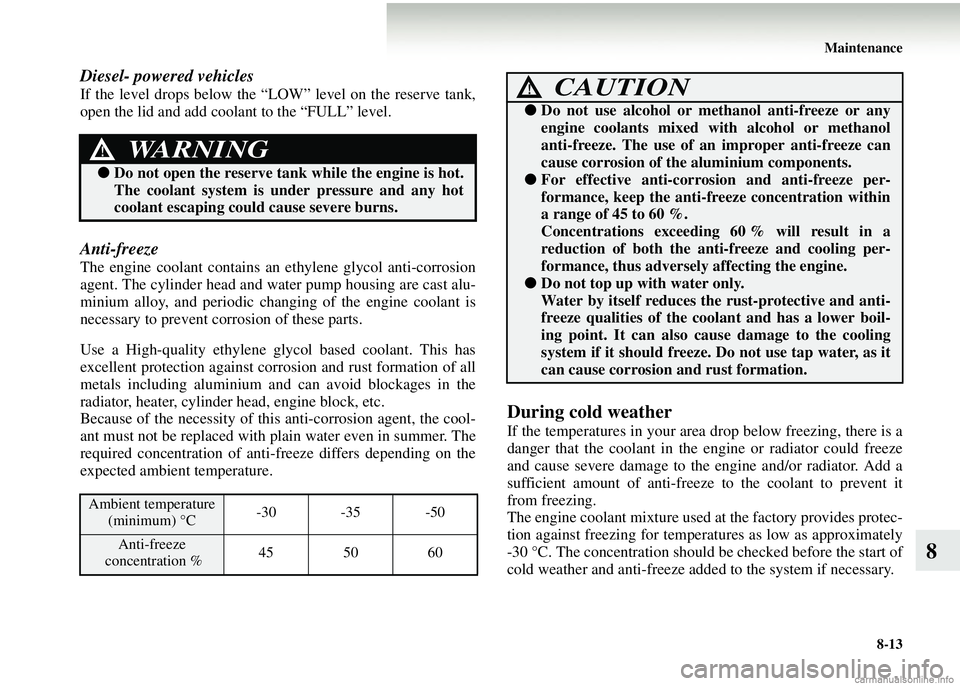
Maintenance8-13
8
Diesel- powered vehicles
If the level drops below the “LOW” level on the reserve tank,
open the lid and add coolant to the “FULL” level.
Anti-freeze
The engine coolant contains an ethylene glycol anti-corrosion
agent. The cylinder head and wa ter pump housing are cast alu-
minium alloy, and periodic changing of the engine coolant is
necessary to prevent corrosion of these parts.
Use a High-quality ethylene glycol based coolant. This has
excellent protection against corros ion and rust formation of all
metals including aluminium and can avoid blockages in the
radiator, heater, cylinder head, engine block, etc.
Because of the necessity of this anti-corrosion agent, the cool-
ant must not be replaced with plain water even in summer. The
required concentration of anti -freeze differs depending on the
expected ambient temperature.
During cold weather
If the temperatures in your ar ea drop below freezing, there is a
danger that the coolant in the engine or radiator could freeze
and cause severe damage to the engine and/or radiator. Add a
sufficient amount of anti-freeze to the coolant to prevent it
from freezing.
The engine coolant mixture used at the factory provides protec-
tion against freezing for temperat ures as low as approximately
-30 °C. The concentration should be checked before the start of
cold weather and anti-freeze added to the system if necessary.
WARNING!
●Do not open the reserve tank while the engine is hot.
The coolant system is under pressure and any hot
coolant escaping coul d cause severe burns.
Ambient temperature
(minimum) °C -30 -35 -50
Anti-freeze
concentration % 45 50 60
CAUTION!
●
Do not use alcohol or me thanol anti-freeze or any
engine coolants mixed with alcohol or methanol
anti-freeze. The use of an improper anti-freeze can
cause corrosion of the aluminium components.
● For effective anti-corro sion and anti-freeze per-
formance, keep the anti -freeze concentration within
a range of 45 to 60 %.
Concentrations exceeding 60 % will result in a
reduction of both the an ti-freeze and cooling per-
formance, thus adversel y affecting the engine.
●Do not top up with water only.
Water by itself reduces th e rust-protective and anti-
freeze qualities of the cool ant and has a lower boil-
ing point. It can also cause damage to the cooling
system if it should freeze. Do not use tap water, as it
can cause corrosion and rust formation.
Page 370 of 450
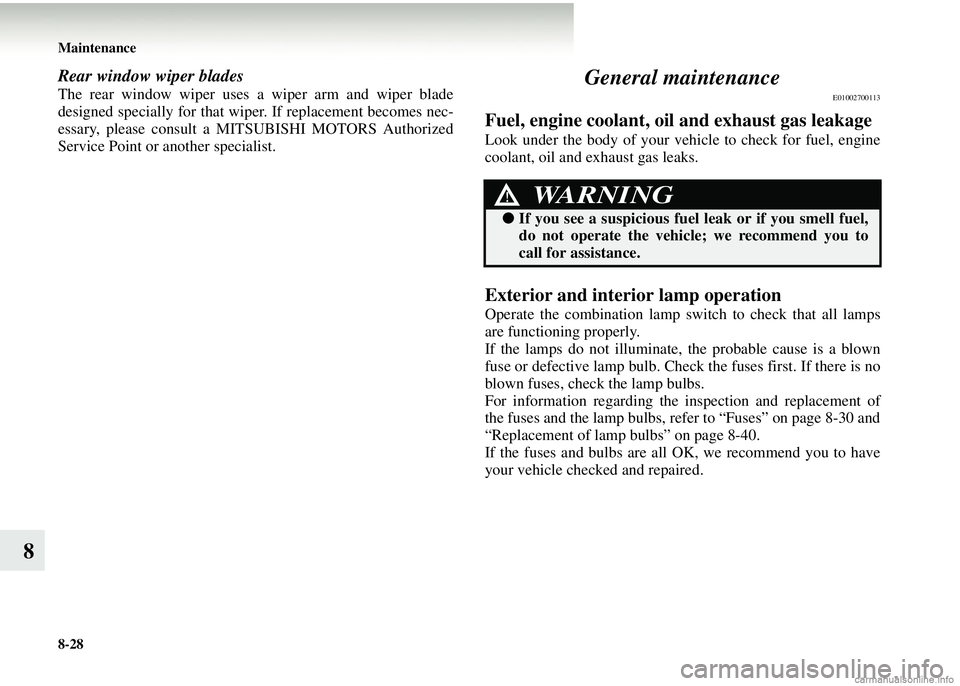
8-28 Maintenance
8
Rear window wiper blades
The rear window wiper uses a wiper arm and wiper blade
designed specially for that wipe r. If replacement becomes nec-
essary, please consult a MITSUBISHI MOTORS Authorized
Service Point or another specialist.General maintenance
E01002700113
Fuel, engine coolant, o il and exhaust gas leakage
Look under the body of your vehicle to check for fuel, engine
coolant, oil and exhaust gas leaks.
Exterior and interior lamp operation
Operate the combination lamp sw itch to check that all lamps
are functioning properly.
If the lamps do not illuminate, the probable cause is a blown
fuse or defective lamp bulb. Check the fuses first. If there is no
blown fuses, check the lamp bulbs.
For information regarding th e inspection and replacement of
the fuses and the lamp bulbs, refer to “Fuses” on page 8-30 and
“Replacement of lamp bu lbs” on page 8-40.
If the fuses and bulbs are all OK, we recommend you to have
your vehicle checked and repaired.
WARNING!
● If you see a suspicious fuel leak or if you smell fuel,
do not operate the vehicle; we recommend you to
call for assistance.
Page 434 of 450
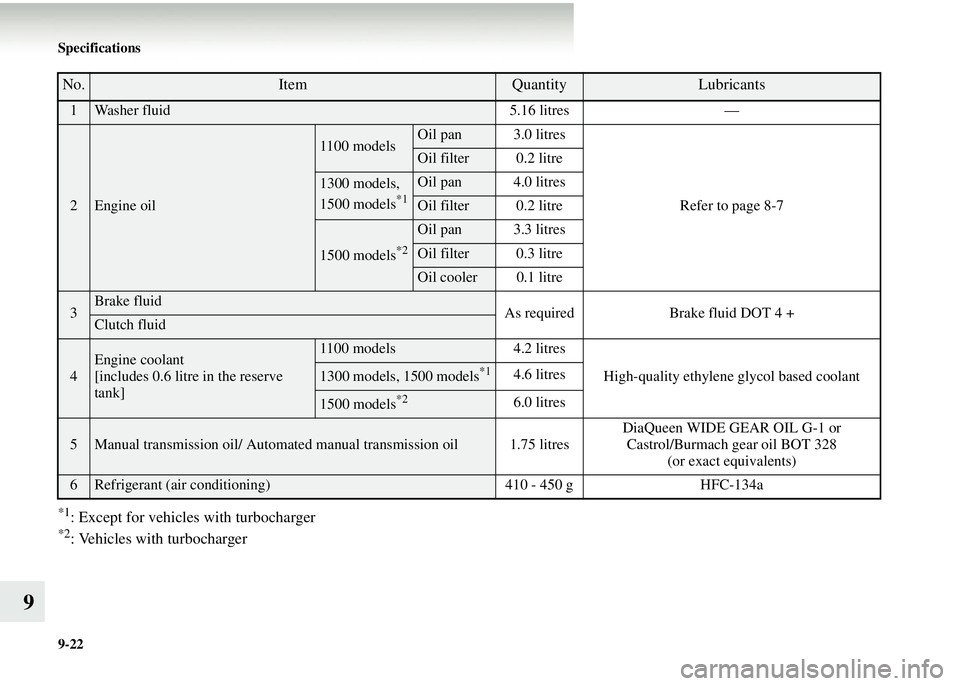
9-22 Specifications
9
*1: Except for vehicles with turbocharger*2: Vehicles with turbocharger
No.ItemQuantityLubricants
1Washer fluid5.16 litres—
2Engine oil
1100 modelsOil pan 3.0 litres
Refer to page 8-7
Oil filter 0.2 litre
1300 models,
1500 models*1
Oil pan 4.0 litres
Oil filter 0.2 litre
1500 models*2
Oil pan 3.3 litres
Oil filter 0.3 litre
Oil cooler 0.1 litre
3Brake fluid As requiredBrake fluid DOT 4 +
Clutch fluid
4
Engine coolant
[includes 0.6 litre in the reserve
tank]1100 models 4.2 litres
High-quality ethylene glycol based coolant
1300 models, 1500 models*14.6 litres
1500 models*26.0 litres
5Manual transmission oil/ Automated manual transmission oil 1.75 litres DiaQueen WIDE GEAR OIL G-1 or
Castrol/Burmach gear oil BOT 328 (or exact equivalents)
6Refrigerant (air conditioning) 410 - 450 gHFC-134a
Page 435 of 450
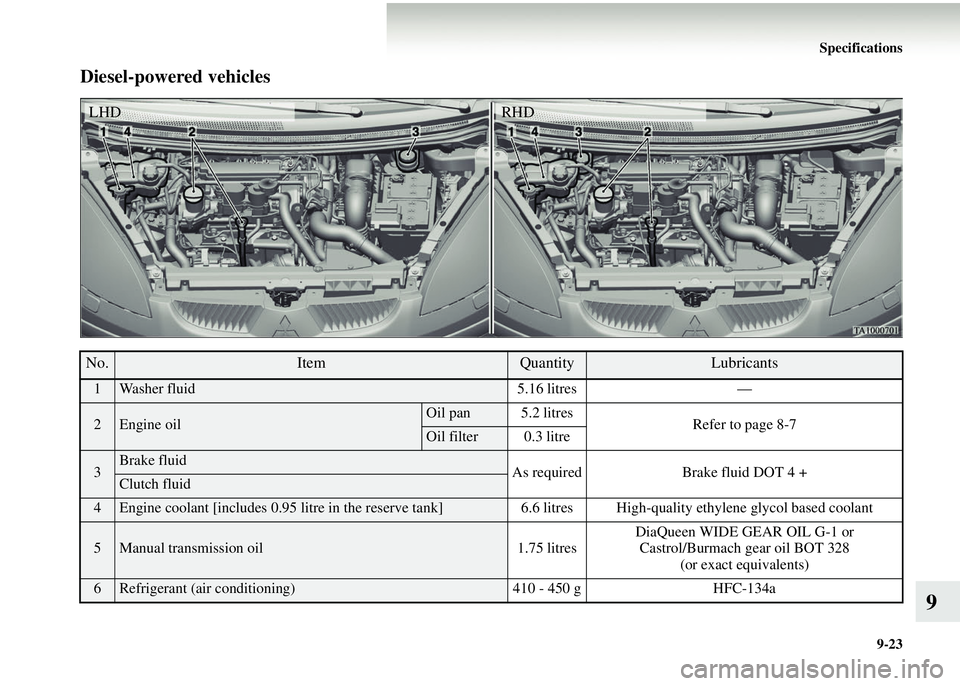
Specifications9-23
9
Diesel-powered vehicles
No.ItemQuantityLubricants
1Washer fluid 5.16 litres—
2Engine oilOil pan 5.2 litres
Refer to page 8-7
Oil filter 0.3 litre
3Brake fluid
As requiredBrake fluid DOT 4 +
Clutch fluid
4Engine coolant [includes 0.95 litre in the reserve tank] 6.6 litres High-quality ethylene glycol based coolant
5Manual transmission oil1.75 litresDiaQueen WIDE GEAR OIL G-1 or
Castrol/Burmach gear oil BOT 328 (or exact equivalents)
6Refrigerant (air conditioning) 410 - 450 gHFC-134a
LHD RHD
Page 438 of 450
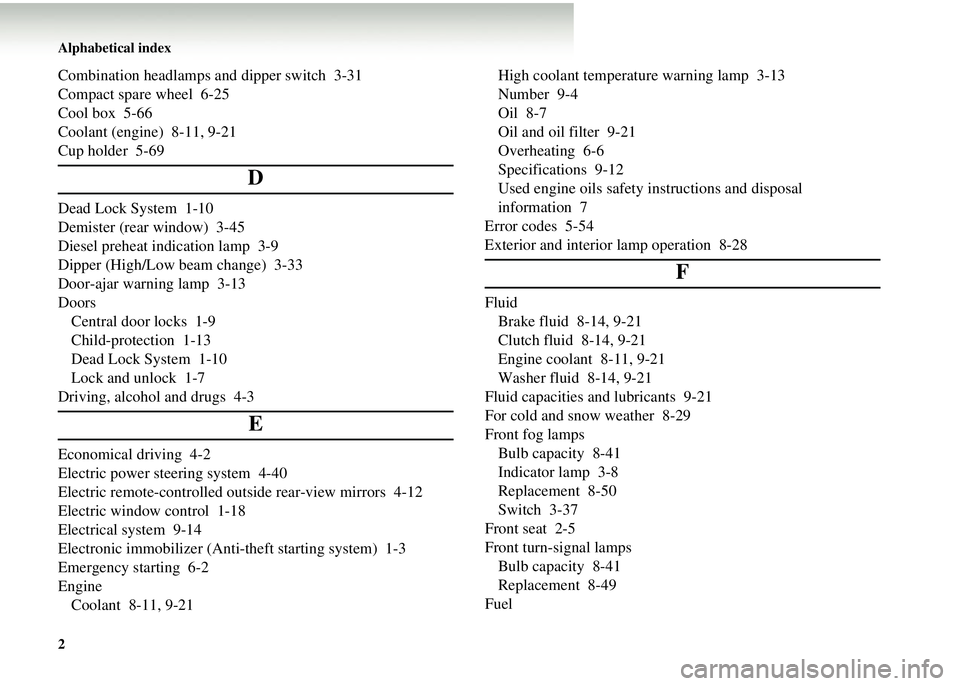
Alphabetical index
2
Combination headlamps and dipper switch 3-31
Compact spare wheel 6-25
Cool box 5-66
Coolant (engine) 8-11, 9-21
Cup holder 5-69
D
Dead Lock System 1-10
Demister (rear window) 3-45
Diesel preheat indication lamp 3-9
Dipper (High/Low beam change) 3-33
Door-ajar warning lamp 3-13
Doors Central door locks 1-9
Child-protection 1-13
Dead Lock System 1-10
Lock and unlock 1-7
Driving, alcohol and drugs 4-3
E
Economical driving 4-2
Electric power steering system 4-40
Electric remote-controlled outside rear-view mirrors 4-12
Electric window control 1-18
Electrical system 9-14
Electronic immobilizer (Anti-theft starting system) 1-3
Emergency starting 6-2
Engine Coolant 8-11, 9-21 High coolant temperat
ure warning lamp 3-13
Number 9-4
Oil 8-7
Oil and oil filter 9-21
Overheating 6-6
Specifications 9-12
Used engine oils safety instructions and disposal
information 7
Error codes 5-54
Exterior and interior lamp operation 8-28
F
Fluid Brake fluid 8-14, 9-21
Clutch fluid 8-14, 9-21
Engine coolant 8-11, 9-21
Washer fluid 8-14, 9-21
Fluid capacities and lubricants 9-21
For cold and snow weather 8-29
Front fog lamps Bulb capacity 8-41
Indicator lamp 3-8
Replacement 8-50
Switch 3-37
Front seat 2-5
Front turn-signal lamps Bulb capacity 8-41
Replacement 8-49
Fuel
Page 439 of 450
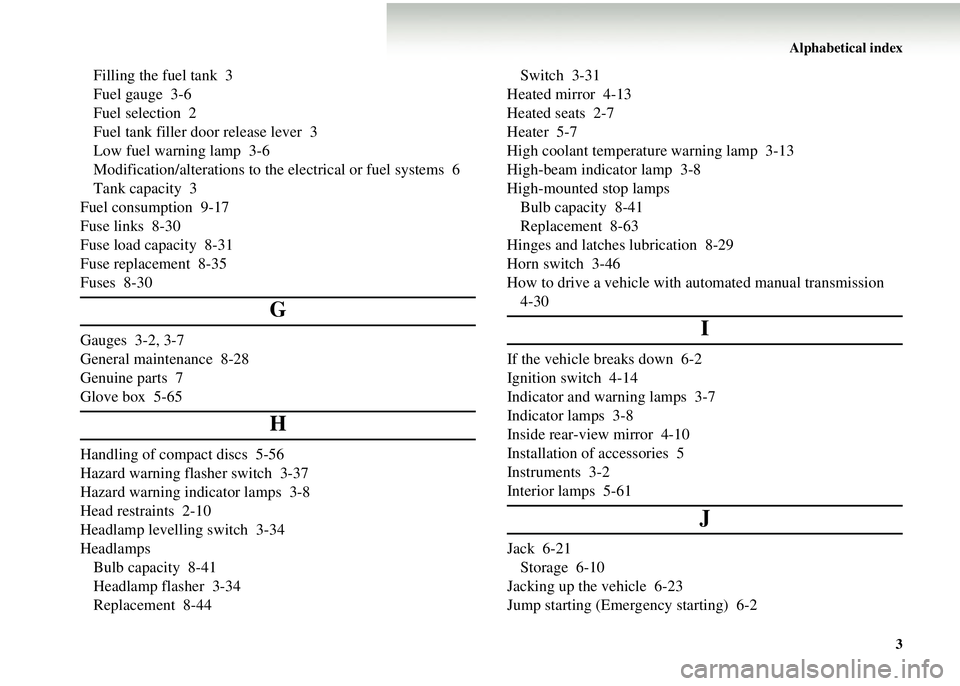
Alphabetical index3
Filling the fuel tank 3
Fuel gauge 3-6
Fuel selection 2
Fuel tank filler door release lever 3
Low fuel warning lamp 3-6
Modification/alterations to th e electrical or fuel systems 6
Tank capacity 3
Fuel consumption 9-17
Fuse links 8-30
Fuse load capacity 8-31
Fuse replacement 8-35
Fuses 8-30
G
Gauges 3-2, 3-7
General maintenance 8-28
Genuine parts 7
Glove box 5-65
H
Handling of compact discs 5-56
Hazard warning fl asher switch 3-37
Hazard warning i ndicator lamps 3-8
Head restraints 2-10
Headlamp levelling switch 3-34
Headlamps Bulb capacity 8-41
Headlamp flasher 3-34
Replacement 8-44 Switch 3-31
Heated mirror 4-13
Heated seats 2-7
Heater 5-7
High coolant temperature warning lamp 3-13
High-beam indicator lamp 3-8
High-mounted stop lamps Bulb capacity 8-41
Replacement 8-63
Hinges and latches lubrication 8-29
Horn switch 3-46
How to drive a vehicle with automated manual transmission 4-30
I
If the vehicle breaks down 6-2
Ignition switch 4-14
Indicator and warning lamps 3-7
Indicator lamps 3-8
Inside rear-view mirror 4-10
Installation of accessories 5
Instruments 3-2
Interior lamps 5-61
J
Jack 6-21Storage 6-10
Jacking up the vehicle 6-23
Jump starting (Emerg ency starting) 6-2